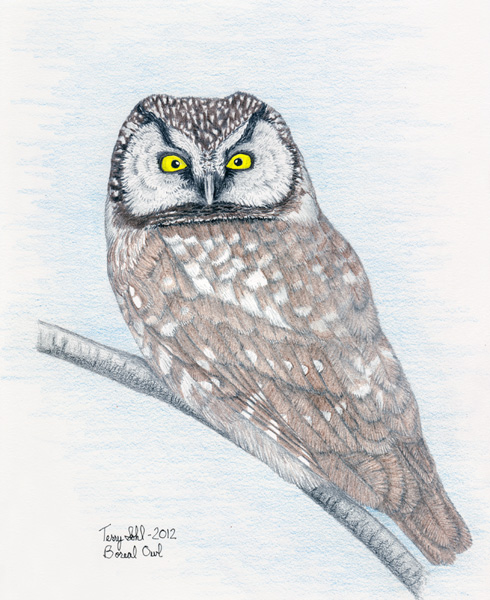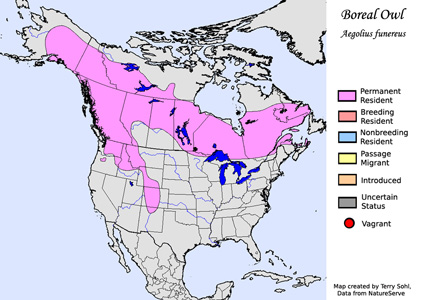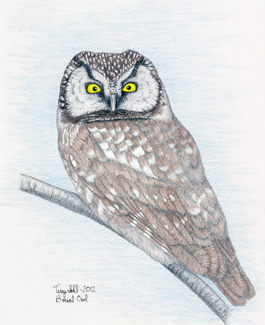| Length: 8 to 12 inches | Wingspan: 20 to 26 inches | Seasonality: Rare Visitor |
| ID Keys: Black rim around pale face, pale bill, white underparts with heavy dark streaking, dark brown upperparts with white spotting | ||
 The Boreal Owl is a
reclusive owl rarely seen by humans in North America, as they prefer boreal
forests of Canada and Alaska and upper-elevation mixed conifer forests of the
western U.S. In addition, they are highly nocturnal, and generally are
only vocal during the early spring. Prior to the 1970s, it was thought
they only bred in Canada, until populations started to be discovered at higher
elevations in the western U.S. They can also be found in Eurasia.
The Boreal Owl is a
reclusive owl rarely seen by humans in North America, as they prefer boreal
forests of Canada and Alaska and upper-elevation mixed conifer forests of the
western U.S. In addition, they are highly nocturnal, and generally are
only vocal during the early spring. Prior to the 1970s, it was thought
they only bred in Canada, until populations started to be discovered at higher
elevations in the western U.S. They can also be found in Eurasia.
Habitat: Prefers mixed coniferous forest for breeding, especially spruce or fir mixed with aspen or birch. These habitats can be found at lower elevations throughout much of its range in Canada and Alaska. In the southern part of its range, they are primarily found in higher elevations.
Diet: Primarily feeds on small mammals. Will also eat small birds and insects.
Behavior: Nocturnal, doing nearly all its hunting at night. Hunts by observing from a perch, swooping down to snag prey in its talons when spotted. Capable of hunting with a bare minimum of light, hunting by sound alone.
Breeding: Non-breeder in South Dakota. In breeding range, the nest of a Boreal Owl is a cavity in a tree. The female usually lays 3 or 4 eggs, with the female alone incubating them. When the eggs hatch, the female stays with the young most of the time, with the male bringing food. The young leave the nest after about one month, but are fed by the parents for another couple of weeks.
Song: Series of short rising ringing notes.
Migration: Populations are generally non-migratory, but there are occasional southward irruptions during winters when prey is scarce in their normal range.
Interactive eBird Map: Click to access an interactive eBird map of Boreal Owl sightings
Similar Species: Northern Saw-whet Owl, Northern Pygmy-Owl
Conservation Status: It's difficult to identify trends in populations due to their normal habitat and reclusive nature, but it's believed their numbers are generally stable. The IUCN lists the Boreal Owl as a species of "Least Concern".
Further Information: 1) Patuxent Bird Identification InfoCenter, Boreal Owl
Image Information: Colored pencil drawing by Terry Sohl
| Click on the map below for a higher-resolution view |
 |
| South Dakota Status: Rare visitor, with only a handful of records in the state. |
Additional Boreal Owl Images
Click for a higher-resolution version of these images

